Hydrogen is an alternative source of fuel (alternative to fossil fuels), but it can be produced from renewable or non-renewable sources. PBS and Scientific American Frontiers have a nice video on hydrogen fuel. They first visit a lab producing hydrogen fuel cells. The second part of the program visits Iceland is trying to use geothermal energy to create the hydrogen. They also discuss producing hydrogen from solar-electric and algae.
Author: Lensyl Urbano
Geothermal energy and plate tectonics
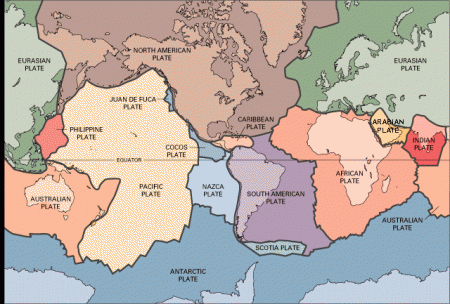
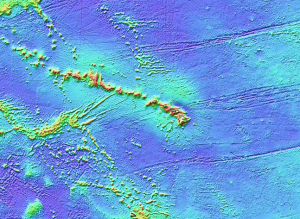
The question came up about where are good places for geothermal energy, and the answer, of course, was to introduce plate tectonics. It was a quick introduction, and a refresher for the 8th graders, but the interest was there and it seemed impactful.
It also provided a link to talk about the Icelandic volcano that’s been disrupting air traffic in Europe. NASA has an amazing picture of the eruption on its Picture of the Day for April 19th.
Google Maps is a great tool for showing features like the mid-ocean ridges (use the satellite view), zooming in and out of the mountain ranges, tracing the Hawaii hotspot and watching East Africa split apart.
[googleMap name=”Mozambique Channel” description=”East African Rifting” width=”400″ height=”350″ mapzoom=”4″ mousewheel=”false” directions_to=”false”]-21, 40[/googleMap]
Oil traps and deltas in the sandbox
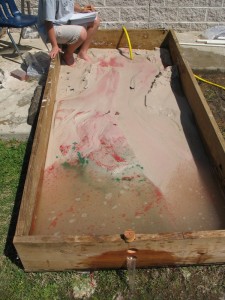
The sandbox was built to be a wave tank so we could look at interference patterns and wave properties. But if you tilt it a little, and put in a few holes on the lower end, you can get sandbox to look at the formation of streams, deltas and the sedimentary layering that traps oil and natural gas.
Using the holes at the bottom end the students started with a low “sea-level”, raised it and lowered it. At the end of the run, they drained all the water and sliced the tank to see the depositional layers in cross-section.
We added red and green sand to try to make marker beds before each change in base level. The marker beds worked reasonably well, but it would have been better to have sand with different densities that could be sorted by the stream flow and depositional environment. It also helps to get the colored sand wet, to make a slurry, otherwise the grains will float on the water.
The shifting lobes of the delta showed up very well (see the animation) and some nice river features showed up as well. What I want to do sometime is to have students build coastlines and have waves erode them away creating typical coastal features.
My students were even able to demonstrate the tank for their presentation, because it really only takes half an hour to get all the features if you know what you’re aiming for.
Sources
The exercise these results are based on is posted as The Geology of Oil Traps Activity.
Poetry for adolescents
I’m always a little suspicious of things titled as “for adolescents” or similar, because they tend to satisfy someone’s memory of being young and don’t necessarily provide what adolescents actually need. Of course I’m guilty of the same bias but I do take some effort be aware and to be critical of my own choices because of it. That said, I listened to a couple of poems from Elise Paschen’s compilation of poetry for adolescents, “Poetry Speaks Who I Am: Poems of Discovery, Inspiration, Independence and Everything Else” on NPR’s Morning Edition today and some of them are pretty good.
The poetry anthology comes with a CD, and Paschen reads a few on the program. She also goes on to talk about the poems a little, giving a good example about how to respond to poetry. The first poem they discuss on the program, Rita Dove’s Flash Cards, though written from the point of view of a younger student, is quite good. There are also a couple of poems on the NPR article.
Since we’re still having poetry presentations in the morning I think it would be useful to play part of this interview to help shape the discussion.
Steam distillation
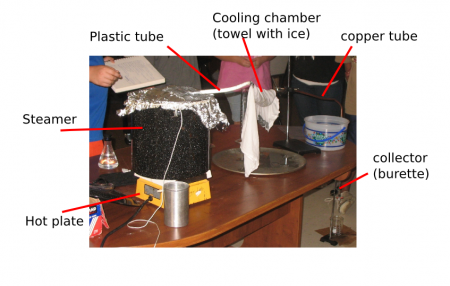
We’re talking about the carbon cycle and the production of fossil fuels, so I though it would be interesting to try extracting oils from plants, to demonstrate that it can be done. So one of my small groups put together a steam distillation apparatus using stuff that we had at hand and a length of copper tubing that we picked up at the hardware store.
We tried extracting the essential oils from lemon balm, because it grows like a weed here and even this early in the spring I have too much of it in the back yard (the middle school does not yet have an herb garden).
The distiller apparatus worked fairly well itself. Our improvised cooling chamber was a towel with ice in it draped over the copper tube. The melted ice-water would wick up the towel and evaporate as the water cooled the copper tube. You could see the steam rising off the the towel, an excellent example of phase changes in water resulting from transfers of energy.
We did not get any nice oil separation in the distillate, probably because we did not use enough lemon balm, but we got wonderfully fragrant water (in the flask on the left side of the picture). The water left behind in the pot also turned an ugly brown and looked a bit like crude oil (or tea) at least in a test tube.
Planes versus the volcano

David McCandless’ graphic showing the amount of CO2 emitted by the European airline industry compared to the amount emitted by the volcano that shut down that industry for several days is beautiful in its simplicity. It seems that despite the fact that volcanoes emit a lot of CO2, the volcanic eruption reduced total emissions of carbon dioxide into the atmosphere.
Passive solar collector project
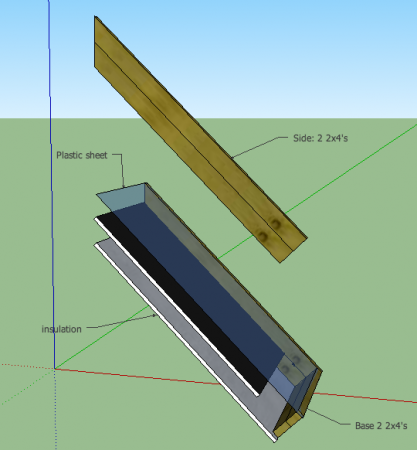
For real experiential learning, projects should have useful, practical applications. This passive, solar heat collector window unit seems pretty easy to build (you’ll find out more about it in about a week). It’s passive because there are no fans to push the air through the collector, the air flows through it because of the hot air in the upper channel rises, creating a siphoning effect that drags cool air into the lower chamber. With a couple solar cells and spare electric motors from some toy cars, however, we should be able to turn it into an active, forced-convection heater. What’s nice, is that we can now demonstrate two methods of capturing solar energy.

This project may also work well if it’s split into two, the solar collector and the photoelectric fan system, and at the end the students bring them both together to create a single unit.
Directions to build similar units can be found on the Build it Solar website and the Solar Heater page. Mother Earth News has an article from 1977 on how to construct one. These images were produced from a Google SketchUp model, which is really useful in trying to prototype little constructions like this. Though, I probably spend too much time trying to get the models to look just right.
The Build it Solar website is a great resource for practical solar projects.
Methane hydrates for energy
Despite the fact that methane is a powerful greenhouse gas itself and burning it produces carbon dioxide there is currently quite a bit of research on extracting methane hydrates from the sea floor as an alternative to the traditional fossil fuels because there is just so much of it. Discovery Channel has an interesting video on the topic where they burn some methane hydrate ice.
Methane releases from the arctic and sea-floor could also trigger rapid climate change. Recent discoveries suggest that global warming is warming the arctic so much that the permafrost is melting an releasing a lot of methane into the atmosphere. If the arctic atmosphere continues to warm, more methane will be released, causing more warming …. This positive feedback loop would accelerate global warming. Some scientists worry that warmer ocean waters can melt methane hydrates at the sea floor releasing them into the atmosphere in a similar positive feedback loop.

